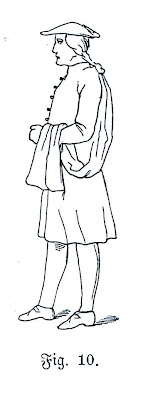During his visit to Germany, His Holiness Pope Benedict XVI visited on 23 of September 2011 the
Evangelical Monastery of St Augustine's in Erfurt to talk to a delegation of the EKD - Evangelical Church in Germany. I received some emails asking me questions about the Evangelical headgear.
Let's first have a look at 3 icons of the Protestant Reformation (1517 - 1648):
Let's first have a look at 3 icons of the Protestant Reformation (1517 - 1648):
At the first glimpse the barett they are wearing is very similar to the Canterbury Cap.
Luther himself mentioned in his letter to Georg Buchholzer, 4th December 1539 a "Chorkappe". "Chor" from "choir stall" and "Kappe" form "cap" so from the word a hat/cap worn when sitting in the choir-stall. But it is more than likly, that the "Chorkappe" Luther is refering to is not a hat but some kind of collar worn above the chasuable. I never saw a painting Luther wearing a pileolus.
Two other expressions I found in the German literature were "Kalottenmütze" (calotte beanie) and "Mütze aus Sammet" (beanie made of velvet).
Tilemann Heshusius (1527-1588) wearing some kind of "Kalottenmütze"
Johannes Valentinus Andreae (1586-1654) with "Kalottenmütze"
Philipp Jakob Spener (1635-1705) wearing a "Kalottenmütze"
Heinrich Müller (1631-1675) with "Kalottenmütze"
Skullcap covering the entire skull
Maybe the "Kalottenmütze" was something like that.
The Evangelical Barett developed from the scholar's garb in use in Germany in the 16th century. Some of the sources (see below under "literature") mentioned the clothing of the citizens of the 16th century as provenance of the barett.
Petrus Schumann (1533-1589), as well known as Petrus Hypodemander Ferrimontanus
Superintendent and Priest
Priest in Nuremberg wearing talar and barett
The uppermost preachers in Zurich from 1519 to 1719
On the top the pastors still wear a baret, below, the portraits below
Philipp Melanchton (1497 - 1560) in the scholar's garb
George III, Prince of Anhalt-Dessau (1507-1553)
Protestant Bishop of Merseburg
wearing a red barett
Ernst Ludwig von Spiegel zum Diesenberg (1711 - 1785)
evangelical Domdechant in Halberstadt (1756 - 1785)
Painting of E. Bekly, 1756.
Kurfürst Joachim II. receives the Holy Comunion out of the hand of
Bishop Matthias von Jagow, Brandenburg, 1539
Painting of Carl Röhling, 1913, St. Nicolai, Berlin - Spandau
Bishop Matthias von Jagow, Brandenburg, 1539
Painting of Carl Röhling, 1913, St. Nicolai, Berlin - Spandau
On the left hand side you see Wolfgang zu Arnim, Propst zu Salzwedel wearing a black hat similar to the orthodox skufia.
On the rigth hand side (behind the bishop in black) you see Propst Georg Buchholzer wearing a black "Chorkappe" very close to the pileolus.
Design for "Beffchen" and Barett, made by the Bavarian (theater)painter (costume designer) Georg Frieß
Instruction of King Fredrick Wilhelm I of Prussia of 1st January 1811 how the talar, the "Beffchen" and the barett has to look like in Prussia
Drawings out of the book:
Bringemeier, Martha: Priester- und Gelehrtenkleidung
Nowadays the following baretts are more or less in use in Germany.
Mainly they are used by the Evangelical Pfarrer during their service outside of the church (i.e. funeral services on the cemetery, ...) or if they enter by a procession (mainly with other collegues) in the church.
The names (designations) like Pfälzerbarett, Bayernbarett, Barett Kurhessen-Waldeck,... originate from the different "protestantischen Landeskirchen" we had here in Germany before 1919.
The Lutherbarett is made by craftsmen in th 19th century. It should come out close to this one Luther has worn. The form/design comes from the scholar's barett of the 16th century.
There is not existing something like a "prototype barett" after what all baretts are made. The different forms/designs of the baretts orginates from instructions of the government, communiques by the church authorities or even by the inspiarton of the tailors (hat makers).
Lutherbarett with earmuffs to protect against cold during wintertime
Bayern-/Pfälzerbarett
Lutherbarett
Hannover-Barett
Lutherbarett
Lutherbarett
Nassauerbarett with large front-shield
Nassauerbarett with small front-shield
Bayern-/Pfälzerbarett
Bayern-/Pfälzerbarett
Barett Kurhessen-Waldeck in black
Barett Kurhessen-Waldeck in blue-purple
A very nice and informative booklet:
"Evangelisch betucht"
(in German language with many pictures)
You can order it from:
Literature (all in German language):
Bringemeier, Martha: Priester- und Gelehrtenkleidung: Tunika, Sutane, Schaube, Talar. In: Beitrag zu einer geistesgeschichtlichen Kostümforschung, Volkskundl. Komm. d. Landschaftsverb. Westfalen-Lippe, Rheinisch-westfälische Zeitschrift für Volkskunde, Beiheft, Band 1, Münster, 1974
Monographien zur deutschen Kulturgeschichte XII, Drews, Paul: Der evangelische Geistliche in der deutschen Vergangenheit, Jena 1905
Piepkorn, Arthur Carl: Die liturgischen Gewänder in der lutherischen Kirche seit 1955, Lüdenscheid/Lobetal 1987
Schatz, Helmut: Historische Bilder zum Evangelisch-Lutherischen Gottesdienst, Ansbach 2004
Simon, Matthias: Vom Priesterrock zum Amtsrock in Bayern, in: Zeitschrift für bayerische Kirchengeschichte Jg 34, 1964, pp. 19-61
Strutz, Georg: Amtstracht und Amtskleidung der protestantischen Geistlichen in der Pfalz, in: Blätter für dei pfälzische Kirchengeschichte und religiöse Volkskunde, Jg 26, 1959, Heft 3, pp. 85-102 und Heft 4, pp.145-173
Kunz Dr.: Die gottesdienstlichen Gewänder der Geistlichen, namentlich der evangelischen Kirche, in: Christlichen Kunstblatt für Kirche, Schule und Haus, Jg 21, Oktober 1879, Heft Nr. 10, pp. 145-155
Merkel, Friedemann: Sagen - Hören - Loben, Göttingen, Vadenhoeck & Ruprecht, 1992, pp.205 -217: Schwarz - oder heller? Zur Amtstracht evangelischer Pfarrer







































I very much like the Hannover barett. Where did you buy it?
ReplyDeleteFor the evangelical garb I can recommend the following 2 companies:
ReplyDeleteGewandmeisterei Wasmer, 95188 Issigau, Germany.
Roswitha Eggert, Kirche und Kunst,22087 Hamburg, Germany.